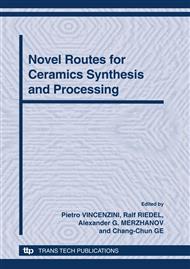p.170
p.175
p.181
p.187
p.197
p.203
p.213
p.222
p.228
Microwave Activated Combustion Synthesis and Compaction in Separate E and H Fields: Numerical Simulation and Experimental Results
Abstract:
Microwaves (MW) at the ISM frequency of 2.45 GHz have been used to ignite the Combustion Synthesis (CS) of pressed ceramic and metallic powders mixtures, using a single-mode applicator (TE103). This experimental apparatus allows to study the separate effect of prevalent electric or magnetic field on the selective heating of the reactive powders compacts, while transferring energy and not heat before and after CS. Microwave activated combustion syntheses (MACS) of TiC-40 wt%Fe and FeAl intermetallic compounds were performed in the two different field configurations (maximum of the electric field (E) and maximum of magnetic field (H)) in order to investigate any possible difference in the reaction mechanism and in the final microstructure of the products. MACS in the maximum of E has also been applied to high temperature materials joining, with the application of a moderate pressure during the irradiation with electromagnetic waves, to promote adhesion and to reduce the newly formed compounds porosity.
Info:
Periodical:
Pages:
197-202
Citation:
Online since:
October 2010
Keywords:
Price:
Сopyright:
© 2010 Trans Tech Publications Ltd. All Rights Reserved
Share:
Citation:


